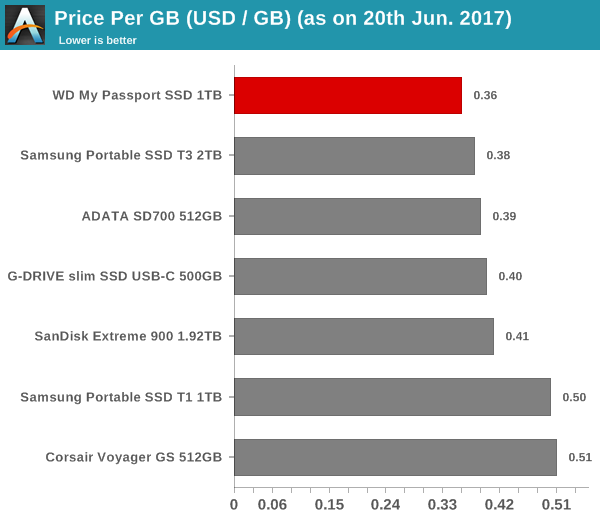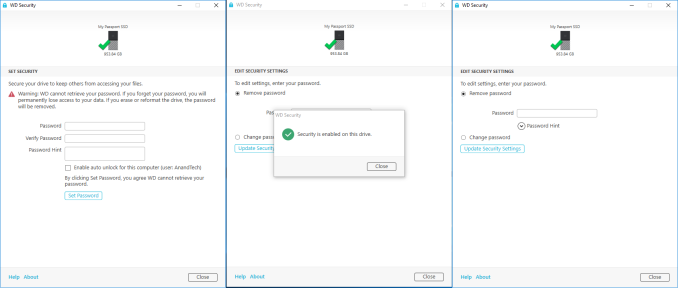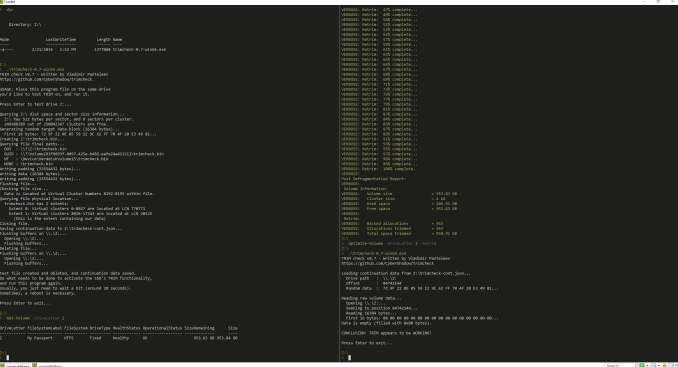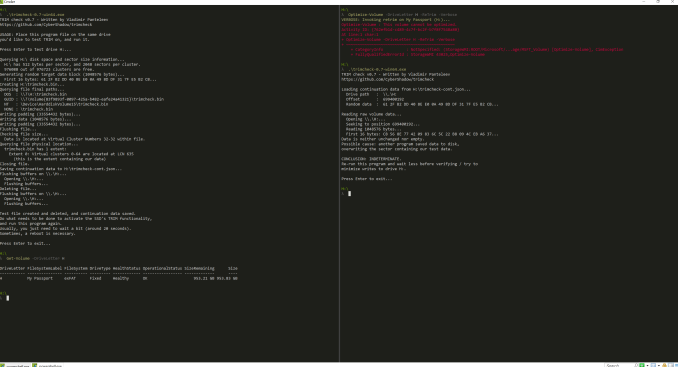Western Digital My Passport SSD Mini-Review
by Ganesh T S on June 28, 2017 8:00 AM EST- Posted in
- Storage
- SSDs
- Western Digital
- DAS
- USB 3.1
Miscellaneous Aspects and Concluding Remarks
The My Passport SSD targets the mainstream market, and its performance in the benchmarks is understandable. However, there are a few things in its favor - the value additions such as hardware encryption and backup software from WD, as well as the price. Before discussing the pros and cons, it is important to check out some other relevant aspects of the product.
USB Host and Encryption Impacts
Our tests above show that we were never able to hit WD's claimed 500 MBps+ numbers even in the artificial benchmarks. In order to identify whether the USB 3.1 Gen 2 host in our testbed (the Intel Alpine Ridge controller) had any negative impact on the device, we processed CrystalDiskMark using one of the USB 3.1 Gen 2 Type-C ports in the Zotac CI523 nano. The USB 3.1 Type-C ports in that PC are enabled by an ASMedia ASM1142 controller.
The above numbers are definitely a step up from what we got with our testbed's USB 3.1 Gen 2 port, indicating that the My Passport SSD is likely to perform better with USB 3.1 Gen 2 ports from an ASMedia controller (between 25 - 35 MBps for sequential workloads, and a significant improvement in write IOPS for random workloads).
We also used this opportunity to test the impact of enabling the TCG Opal 2.0 features of the SSD using the WD Security software. A password is used to protect the contents of the drive, and the software is very simple to use (geared towards the mainstream consumer). The picture below presents some screenshots from the WD Security software.
The CrystalDiskMark workloads were processed on a password protected drive.
Comparing the numbers with the 'no encryption' case above shows that enabling the hardware encryption has almost no discernible impact on the performance. The numbers for both cases are within the run-to-run variations that one usually expects from CrystalDiskMark.
TRIM Support
SanDisk has never enabled TRIM on any of its external SSDs till now. The WD My Passport SSD finally sees a change. The bridge chip is able to map the SCSI Unmap commands to TRIM, as our test below shows. Note that the SSD had to be formatted in NTFS for the manual TRIM command to work.
Triggering a manual TRIM on an exFAT-formatted SSD returned an indeterminate status.
Concluding Remarks
The My Passport SSD completes the efforts of Western Digital to segment the external SSD market segment and divide it up between its three different brands - WD, SanDisk, and G-Technology.
The performance of the My Passport SSD is good enough for the mainstream market, though power users might be disappointed. Western Digital needs to pay more attention to the thermal design for performance consistency. UASP also needs to be enabled in the firmware for the unit to match the performance of similar external SSDs in the market. Western Digital indicated that UASP could be enabled in future production runs, but, no concrete timeframe was provided.
TRIM support makes the My Passport SSD a great choice for a portable OS drive. The product is based on the SanDisk X400 TLC SSD, and this allows for an attractive price point. The MSRP is $400 for the 1TB variant, but, we have seen the Best Buy price fluctuate between $350 and $400 during the time that we tracked it.

The M.2 version of the SanDisk 1TB X400 has a street price of around $330. A M.2 to USB 3.1 Gen 2 enclosure (such as the StarTech SM21BMU31C3) has a street price of $32. The My Passport SSD has a better industrial design, a few software value additions for backup, and also has hardware encryption (not available in the retail M.2 version of the X400). Given the $350 - $400 price range for the My Passport SSD, it is a toss-up between the two options. Mainstream consumers want a plug and play solution, and that gives the My Passport SSD a slight edge in its target market.















22 Comments
View All Comments
Huacanacha - Wednesday, June 28, 2017 - link
That wouldn't make sense as data already on the drive would need to be re-encrypted. Much more likely it's just a simple password that, if set, is required to enable the controller to use the hardcoded key.edzieba - Thursday, June 29, 2017 - link
It's not a 'hard coded' key, just a randomly generated one at initialization. One key is used to encrypt the partition that stores block allocations, and another that encrypts blocks on write. Because the blocks need to be manipulated and encoded before write anyway (to minimise sillyness like all bits in a block being '1') encrypting it at the same time is close to 'free'. Encrypting also gives a nicely high-entropy output so can substitute another stage intended to give high entropy data.This is why a the "SSDs don't really delete your data!!!1" stores are a bit of bunk: If you grab the raw NAND chips and read them back, you get a randomly arranged assembly of blocks of encrypted data. Deleted or not, you're not recovering anything without the key.
edzieba - Thursday, June 29, 2017 - link
Whoops, didn't mean to hit submit yet. The passcode you enter in the drive is just to lock drive controller, and acts similarly to the ATA password of old in that without it the drive controller won't do what you tell it to (and the drive controller holds the actual keys).VulkanMan - Thursday, June 29, 2017 - link
It IS hard coded, you can't change the encryption key on the device.It is set at the factory, and yes, it is randomly generated (well, so we think).
Bullwinkle J Moose - Thursday, June 29, 2017 - link
Wish you had a Corsair GTX in there for comparison instead of the GSI'd rather see only "Bootable" USB drives with Trim/GC compared
A direct comparison of Windows Boot Times and a 100GB copy/paste from and to the same SSD to test internal throughput would tell me everything I need to know
Synthetic tests have no place in the real world!
mr_tawan - Thursday, June 29, 2017 - link
I'd love to see the Passport Wireless version of this. While I'm not certain if it would improve the battery life, I think it could withstand physically abuse better than the mechanical drive. Portable devices should move to Flash storage instead of keep using mechnical drive.jaydee - Thursday, June 29, 2017 - link
"Catering to the mainstream market, it is currently a Best Buy exclusive."Catering to the mainstream market and NOT available on Amazon? Really?
jhoff80 - Thursday, June 29, 2017 - link
Maybe I'm wrong, but I was under the impression that a USB-A male to USB-C female adapter was very much forbidden by the USB-C spec.BMNify - Thursday, June 29, 2017 - link
Anyone can compare this and the ADATA SE730?Belard - Sunday, July 9, 2017 - link
Hmmm... the WD is easily on the bottom end for performance. The thermal throttling should be a concern as that seems to be a major cause for its performance loss.Either the M2 they built is not well done or the VERY nice external case (which is the same style as their external HDD-drives) doesn't remove heat from the M2 SSD. Looking at the other units, even the G-drive run a lot cooler, with Samsung among the coolest.
What is there to recommend on this product, other than its looks? It will sell well of course.